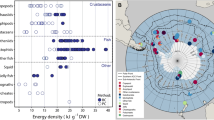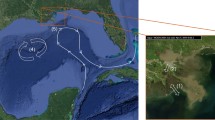Abstract
Ecosystems are not closed, but receive resource subsidies from other ecosystems. Energy, material and organisms are moved between systems by physical vectors, but migrating animals also transport resources between systems. We report on large scale energy transport from ocean to coast by a migrating fish population, the Norwegian spring-spawning (NSS) herring Clupea harengus. We observe a rapid body mass increase during parts of the annual, oceanic feeding migration and we use a bioenergetics model to quantify energy consumption. The model predicts strong seasonal variation in food consumption with a marked peak in late May to July. The copepod Calanus finmarchicus is the most important prey and 23×106 tonnes (wet weight) of C. finmarchicus is consumed annually. The annual consumption-biomass ratio is 5.2. During the feeding migration 17% of consumed energy is converted to body mass. The biomass transported to the coast and left as reproductive output is estimated from gonad weight and is about 1.3×106 tonnes for the current population. This transport is to our knowledge the world’s largest flux of energy caused by a single population. We demonstrate marked temporal variation in transport during the last century and discuss the effects of NSS herring in the ocean, as a major consumer, and at the coast, where eggs and larvae are important for coastal predators. In particular, we suggest that the rapid decline of lobster Homarus gammarus landings in Western Norway during the 1960s was related to the collapse of NSS herring. We also discuss spatial variation in energy transport caused by changed migration patterns. Both climate and fisheries probably triggered historical changes in the migration patterns of NSS herring. New migration routes emerge at the level of individuals, which in turn determines where resources are gathered and delivered, and therefore, how meta-ecosystems function.




Similar content being viewed by others
References
Adams SM, Breck JE (1990) Bioenergetics. In: Schreck CB, Moyle PB (eds) Methods for fish biology. American Fisheries Society, Bethesda, pp 389–415
Aksnes DL, Blindheim J (1996) Circulation patterns in the North Atlantic and possible impact on population dynamics of Calanus finmarchicus. Ophelia 44:7–28
Anon (2004a) Extract of the report of the advisory committee on fishery management. International Council for the Exploration of the Sea, Copenhagen
Anon (2004b) Report of the northern pelagic and the blue whiting fisheries working group. International Council for the Exploration of the Sea, Copenhagen
Arashkevich EG, Tande KSS, Pasternak AF, Ellertsen B (2004) Seasonal moulting patterns and the generation cycle of Calanus finmarchicus in the NE Norwegian Sea, as inferred from gnathobase structures, and the size of gonads and oil sacs. Mar Biol 146:119–132
Ashley MV, Willson MF, Pergams ORW, O’Dowd DJ, Gende SM, Brown JS (2003) Evolutionarily enlightened management. Biol Conserv 111:115–123
Bartell SM, Breck JE, Gardner RH, Brenkert AL (1986) Individual parameter perturbation and error analysis of fish bioenergetics models. Can J Fish Aquat Sci 43:160–168
Beaugrand G, Reid PC, Ibanez F, Lindley JA, Edwards M (2002) Reorganization of North Atlantic marine copepod biodiversity and climate. Science 296:1692–1694
Berthold P, Helbig AJ, Mohr G, Querner U (1992) Rapid microevolution of migratory behavior in a wild bird species. Nature 360:668–670
Bogstad B, Haug T, Mehl S (2000) Who eats whom in the Barents Sea? NAMMCO Scient Publ 2:98–118
Comita GW, Marshall SM, Orr AP (1966) On the biology of Calanus finmarchicus XIII. Seasonal change in weight, calorific value and organic matter. J Mar Biol Ass UK 46:1–17
Conklin DE (1995) Digestive physiology and nutrition. In: Factor JR (ed) Biology of the lobster Homarus americanus. Academic Press, San Diego, pp 441–463
Dale T, Rey F, Heimdal BR (1999) Seasonal development of phytoplankton at a high latitude oceanic site. Sarsia 84:419–435
Dalpadado P, Ellertsen B, Melle W, Dommasnes A (2000) Food and feeding conditions of Norwegian spring-spawning herring (Clupea harengus) through its feeding migrations. ICES J Mar Sci 57:843–857
Devold F (1963) The life history of the Atlanto-scandian herring. Rapp et Proc Verb Cons Int Explor Mer 154:98–108
Dommasnes A, Melle W, Dalpadado P, Ellertsen B (2004) Herring as a major consumer in the Norwegian Sea. ICES J Mar Sci 61:739–751
Dragesund O, Johannessen A, Ulltang O (1997) Variation in migration and abundance of Norwegian spring spawning herring (Clupea harengus L.). Sarsia 82:97–105
Durant JM, Anker-Nilssen T, Hjermann DO, Stenseth NC (2004) Regime shifts in the breeding of an Atlantic puffin population. Ecol Lett 7:388–394
Durant JM, Anker-Nilssen T, Stenseth NC (2003) Trophic interactions under climate fluctuations: the Atlantic puffin as an example. Proc R Soc Lond B 270:1461–1466
Elliott JM, Davison W (1975) Energy equivalents of oxygen-consumption in animal energetics. Oecologia 19:195–201
Engelhard GH, Heino M (2004) Maturity changes in Norwegian spring-spawning herring before, during, and after a major population collapse. Fish Res 66:299–310
Finney BP, Gregory-Eaves I, Sweetman J, Dougas MSV, Smol JP (2000) Impacts of climatic change and fishing on Pacific salmon abundance over the past 300 years. Science 290:795–799
Gresh T, Lichatowich J, Schoonmaker P (2000) An estimation of historic and current levels of salmon production in the Northeast Pacific ecosystem: evidence of a nutrient deficit in the freshwater systems of the Pacific Northwest. Fisheries 25:15–21
Hamre J (1994) Biodiversity and exploitation of the main fish stocks in the Norwegian - Barents Sea ecosystem. Biodivers Conserv 3:473–492
Hanson PC, Johnson TB, Schindler DE, Kitchell JF (1997) Fish Bioenergetics 30 University of Wisconsin Sea Grant Institute
Hassol SJ (2004) ACIA, Impacts of a warming Arctic: Arctic climate impact assessment. Cambridge University Press, Cambridge
Hjermann DO, Ottersen G, Stenseth NC (2004) Competition among fishermen and fish causes the collapse of Barents Sea capelin. Proc Natl Acad Sci USA 101:11679–11684
Holst JC, Dragesund O, Hamre J, Misund OA, Østvedt OJ (2002) Fifty years of herring migration in the Norwegian Sea. ICES Mar Sci Symp 215:352–360
Huse G, Railsback S, Fernö A (2002) Modelling changes in migration pattern of herring: collective behaviour and numerical domination. J Fish Biol 60:571–582
Høines AS, Bergstad OA (1999) Resource sharing among cod, haddock, saithe and pollack on a herring spawning ground. J Fish Biol 55:1233–1257
Krümmel EM, et al (2003) Delivery of pollutants by spawning salmon: fish dump toxic industrial compounds in Alaskan lakes on their return from the ocean. Nature 425:255–256
Laurence GC (1976) Caloric values of some North Atlantic calanoid copepods. Fish Bull 74:218–220
Lid G (1981) Reproduction of the puffin on Røst in the Lofoten islands in 1964–1980. Fauna Norv Ser C, Cinclus 4:30–39
Loreau M, Holt RD (2004) Spatial flows and the regulation of ecosystems. Am Nat 163:606–615
Loreau M, Mouquet N, Holt RD (2003) Meta-ecosystems: a theoretical framework for a spatial ecosystem ecology. Ecol Lett 6:673–679
Marston BH, Willson MF, Gende SM (2002) Predator aggregations during eulachon Thaleichthys pacificus spawning runs. Mar Ecol Prog Ser 231:229–236
McGurk MD, Green JM, McKone WD, Spencer K (1980) Condition indices, energy density and water and lipid content of Atlantic herring (Clupea harengus harengus) of southeastern Newfoundland. Can Tech Rep Fish Aquat Sci:1–41
Misund OA, Melle W, Ferno A (1997) Migration behaviour of Norwegian spring spawning herring when entering the cold front in the Norwegian Sea. Sarsia 82:107–112
Misund OA, et al (1998) Distribution, migration and abundance of Norwegian spring spawning herring in relation to the temperature and zooplankton biomass in the Norwegian Sea as recorded by coordinated surveys in spring and summer 1996. Sarsia 83:117–127
Mullin MM (1969) Production of zooplankton in the ocean: the present status and problems. Oceanogr Mar Biol Ann Rev 7:293–314
Naiman RJ, Bilby RE, Schindler DE, Helfield JM (2002) Pacific salmon, nutrients, and the dynamics of freshwater and riparian ecosystems. Ecosystems 5:399–417
Nøttestad L, Aksland M, Beltestad A, Ferno A, Johannessen A, Misund OA (1996) Schooling dynamics of Norwegian spring spawning herring (Clupea harengus L) in a coastal spawning area. Sarsia 80:277–284
Nøttestad L, Giske J, Holst JC, Huse G (1999) A length-based hypothesis for feeding migrations in pelagic fish. Can J Fish Aquat Sci 56:26–34
Pikitch EK, et al (2004) Ecosystem-based fishery management. Science 305:346–347
Planque B, Batten SD (2000) Calanus finmarchicus in the North Atlantic: the year of Calanus in the context of interdecadal change. ICES J Mar Sci 57:1528–1535
Polis GA, Anderson WB, Holt RD (1997) Toward an integration of landscape and food web ecology: the dynamics of spatially subsidized food webs. Annu Rev Ecol Syst 28:289–316
Rice JA, Cochran PA (1984) Independent evaluation of a bioenergetics model for largemouth bass. Ecology 65:732–739
Rudstam LG (1988) Exploring the dynamics of herring consumption in the Baltic: applications of an energetic model of fish growth. Kiel Meeresforsch 6:312–322
Runnström S (1941) Quantitative investigations on herring spawning and its yearly fluctuations at the west coast of Norway. FiskDir Skr Ser HavUnders 6:1–71
Simila T, Holst JC, Christensen I (1996) Occurrence and diet of killer whales in northern Norway: seasonal patterns relative to the distribution and abundance of Norwegian spring-spawning herring. Can J Fish Aquat Sci 53:769–779
Skjoldal HR, Dalpadado P, Dommasnes A (2004) Food webs and trophic interactions. In: Skjoldal HR (ed) The Norwegain Sea ecosystem. Tapir Academic Press, Trondheim, pp 447–506
Slotte A (1999) Differential utilization of energy during wintering and spawning migration in Norwegian spring-spawning herring. J Fish Biol 54:338–355
Stewart DJ, Binkowski FP (1986) Dynamics of consumption and food conversion by Lake Michigan alewives: an energetics-modeling synthesis. Trans Am Fish Soc 115:643–661
Stewart DJ, Weininger D, Rottiers DV, Edsall TA (1983) An energetics model for lake trout, Salvelinus namaycush: application to the Lake Michigan population. Can J Fish Aquat Sci 40:681–698
Toresen R (1991) Predation on the eggs of Norwegian spring-spawning herring (Clupea harengus L) on a spawning ground on the west-coast of Norway. ICES J Mar Sci 48:15–21
Toresen R, Østvedt OJ (2000) Variation in abundance of Norwegian spring-spawning herring (Clupea harengus, Clupeidae) throughout the 20th century and the influence of climatic fluctuations. Fish Fisheries 1:231–256
Willson MF, Gende SM, Marston BH (1998) Fishes and the forest: expanding perspectives on fish-wildlife interactions. Bioscience 48:455–462
Østvedt OJ (1955) Zooplankton investigations from weathership M in the Norwegian Sea, 1948–1949. Hvalr Skr 40:1–93
Acknowledgements
We thank Dag L. Aksnes, Sigrunn Eliassen, Jens Christian Holst, and two referees for valuable comments on the manuscript. We thank the Directorate of Fisheries for data on lobster landings and Ann-Lisbeth Agnalt for systematizing some of the data. Ø.V. thanks Ann-Lisbeth Agnalt for discussions on lobster biology and catch statistics, and Christian Jørgensen for valuable discussions on several aspects of this work. Ø.V. and Ø.F. acknowledge the Norwegian Research Council for funding.
Author information
Authors and Affiliations
Corresponding author
Additional information
Communicated by Wolf Mooij
Rights and permissions
About this article
Cite this article
Varpe, Ø., Fiksen, Ø. & Slotte, A. Meta-ecosystems and biological energy transport from ocean to coast: the ecological importance of herring migration. Oecologia 146, 443–451 (2005). https://doi.org/10.1007/s00442-005-0219-9
Received:
Accepted:
Published:
Issue Date:
DOI: https://doi.org/10.1007/s00442-005-0219-9




